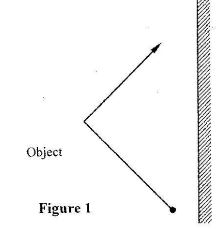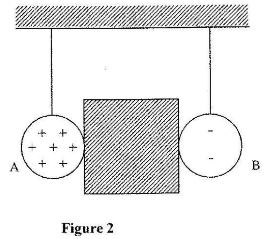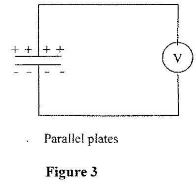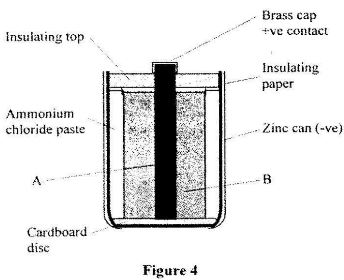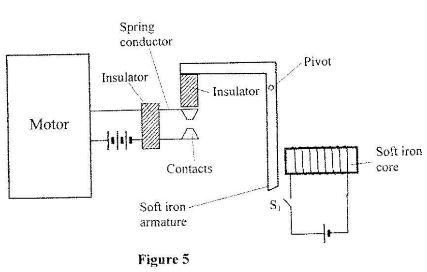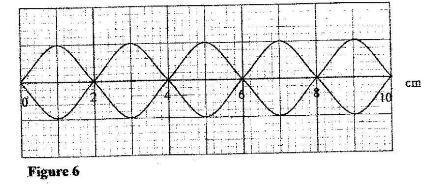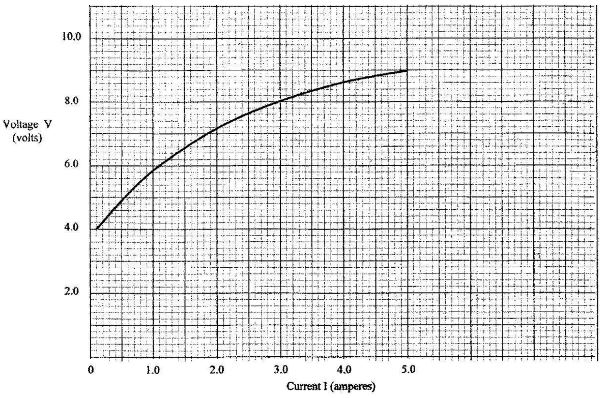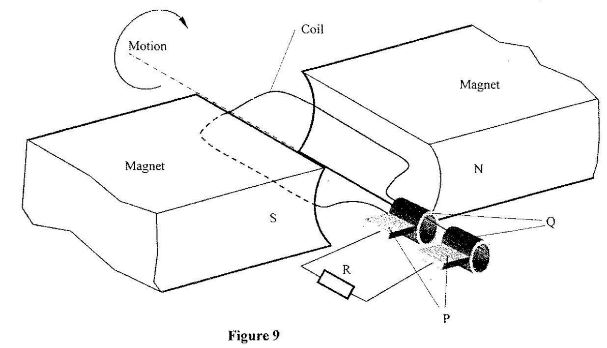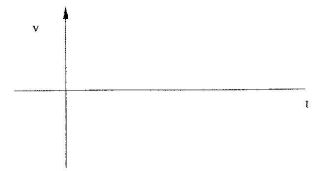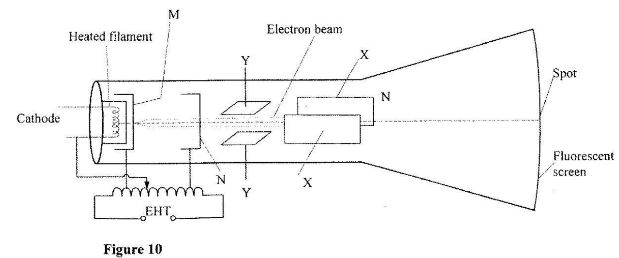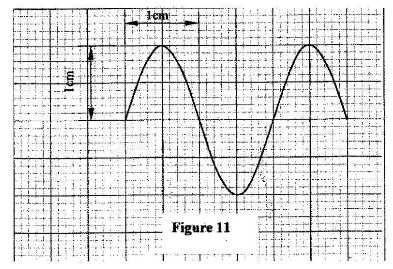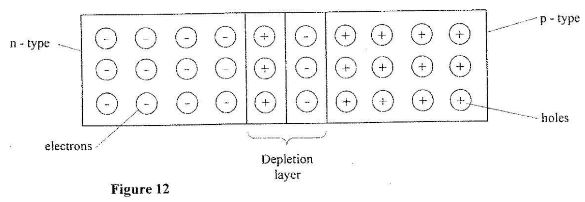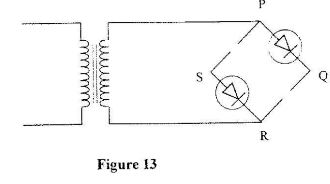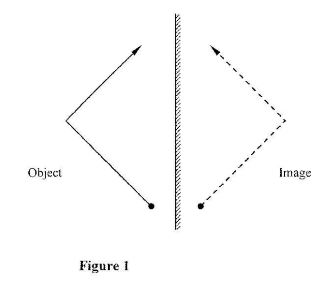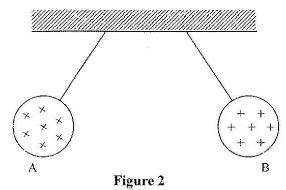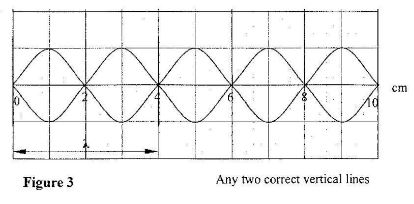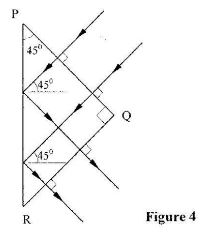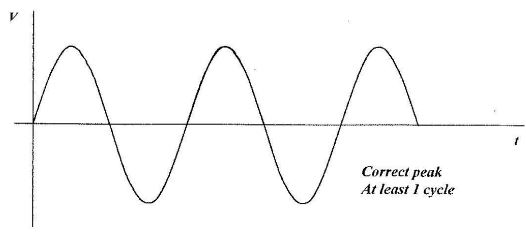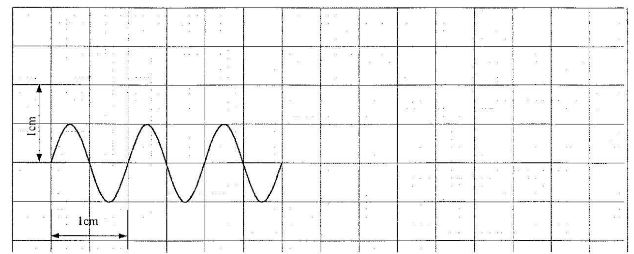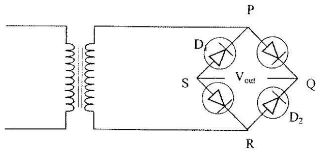SECTION A (25 marks)
Answer all the questions in this section in the spaces provided.
- Figure 1, shows an object placed in front of a plane mirror.
Sketch the image of the object as seen in the mirror.(1 mark) - Figure 2, shows two identical pithballs A and B suspended with insulated threads. They are separated by an insulator X. A is positively charged while B is negatively charged. The quantity of charge on A is three times the quantity of charge on B.
Sketch on the space besides the figure, the final position of the pithballs after the insulator is removed. (1 mark) -
- Figure 3, shows a voltmeter connected across two charged parallel plates.
When a thin sheet of mica is inserted between the plates, the voltmeter reading is observed to reduce. Explain this observation. (3 marks) - Figure 4, shows the cross-section of a dry cell. Use the information on the figure to answer questions 4 and 5.
- Figure 3, shows a voltmeter connected across two charged parallel plates.
- Name the parts labelled A and B.(2 marks)
- State the use of the manganese (IV) oxide in the cell.(1 mark)
- One method of producing a weak magnet is to hold a steel rod in the North South direction and then hammer it continuously for some time. Using the domain theory of magnetism explain how this method works.(2 marks)
Figure 5, shows a motor connected to a magnetic switch called a relay operated by an ordinary switch S,. Use the information in the figure to answer questions 7 and 8. - Explain how the relay switches on the motor when S is closed.(3 marks)
- State with a reason the effect on the motor. if the iron core is replaced with a steel core and switch S, is put on and then off.(2 marks)
- Figure 6, shows standing waves on a string. It is drawn to a scale of 1:5
- Indicate on the diagram the wavelength of the standing wave.(1 mark)
- Determine the wavelength of the wave.(1 mark)
- Figure 7, shows two rays of light incident normally on face PQ of a glass prism, whose critical angle is 42°
Complete the diagram to show the paths of the two rays as they pass through the prism.(3 marks) - A4Ω2 resistor is connected in series to a battery of e.m.f 6V and negligible internal resistance. Determine the power dissipated by the resistor.(2 marks)
- Table 1 shows radiations and their respective frequencies.
Table 1
Type of radiation Yellow light Gamma rays Radio waves Micro waves Frequency(Hz) 1 x 1015 1 x 1022 1 x 106 1 x 1011
Arrange the radiations in the order of increasing energy. (1 mark) - State the reason why electrical power is transmitted over long distances at very high voltages.(1 mark)
- State the meaning of the term "threshold frequency" as used in photoelectric emission.(1 mark)
SECTION B (55 marks)
Answer all the questions in this section in the spaces provided.
-
- Figure 8, shows a graph of potential difference V (volts) against a current I (amperes) for a certain device.
From the graph:- state with a reason whether or not the device obeys ohms law.(2 marks)
- determine the resistance of the device at;
- I = 1.5A (2 marks)
- I = 3.5A(2 marks)
- From the results obtained in (ii) state how the resistance of the device varies as the current increases.(1 mark)
- State the cause of this variation in resistance.(1 mark)
- Three identical dry cells each of e.m.f. 1.6V are connected in series to a resistor of 11.42. A current of 0.32A flows in the circuit. Determine:(1 mark)
- the total e.m.f. of the cells;
- the internal resistance of each cell;(3 mark)
- Figure 8, shows a graph of potential difference V (volts) against a current I (amperes) for a certain device.
-
- State the meaning of the term "principal focus" as applied in lenses.(1 mark)
- You are provided with the following apparatus to determine the focal length of a lens:
- a biconvex lens and lens holder.
- a lit candle.
- a white screen.
- a metre rule
- Draw a diagram to show how you would arrange the above apparatus to determine the focal length of the lens(1 mark)
- Describe the procedure you would follow.(1 mark)
- State two measurements that you would take.(2 marks)
- Explain how the measurements in (iii) would be used to determine the focal length.(2 marks)
- An object is placed 30cm in front of a concave lens of focal length 20cm.
Determine the magnification of the image produced.(4 marks)
-
- State what is meant by the term “electromagnetic induction".
- Figure 9, shows a simple electric generator
- Name the parts labelled P and Q. (2 marks)
- Sketch on the axes provided, a graph to show how the magnitude of the potential difference across R, changes with the time t.(1 mark)
- State two ways in which the potential difference produced by such a generatorcan be increased.(2 marks)
- In a transformer, the ratio of primary turns to the secondary turns is 1:10. A current of 500mA flows through a 20022 resistor in the secondary circuit. Assuming that the transformer is 100% efficient, determine:
- the secondary voltage;(1 mark)
- the primary voltage;(2 marks)
- the primary current.(2 marks)
-
- State two differences between cathode rays and electromagnetic radiations.(2 marks)
- Figure 10, shows the main features of a cathode ray oscilloscope (CRO).
- Name the parts labelled M and N.(2 marks)
- Explain how electrons are produced in the tube.(2 marks)
- When using the CRO to display waveforms of voltages, state where the following should be connected:
- the voltage to be displayed on the screen;
- the time base voltage.(1 mark)
- state why the tube is highly evacuated.(1 mark)
- Figure 11, shows the waveform of a voltage displayed on the screen of a CRO. The Y-gain calibration was 5V per cm.
- Determine the peak-to-peak voltage of the Y-input.(1 mark)
- Sketch on the same figure the appearance of the waveform after the voltage of the input signal is halved and it's frequency is doubled.(2 marks)
-
- When a radiation was released into a diffusion cloud chamber, short thick tracks were observed. State with a reason, the type of radiation that was detected. (2 marks)
- The half-life of an element X is 3.83 days. A sample of this element is found to have an activity rate of 1.6 x 103 disintegrations per second at a particular time. Determine its activity rate after 19.15 days.(2 marks)
- State what is meant by an extrinsic semiconductor.(1 mark)
- Figure 12, shows a depletion layer in an unbiased p-n junction,
State how a battery can be used to make the depletion layer narrower.(1 mark) - Figure 13, shows an incomplete circuit of a full wave rectifier.
- Draw in the figure two more diodes to complete the circuit.(2 marks)
- Show on the figure the points across which the output of the rectifier should be obtained.(1 mark)
MARKING SCHEME
-
-
- Mica raises capacitance; hence lower potential difference; since V=Q/C but Q is constant.
- A=Carbon rod (+); (1 mark)
B=Manganese (VI) oxide (1 mark) - Manganese (IV) oxide is a depolarizer/oxiding agent;(1 mark)
- Hammering causes domains/domains to vibrate; As they settle, some face North South due to earth's magnetic field;(2 mark)
- When S is closed, current flows in solenoid magnetizing the iron core; this attracts the iron armature closing the contacts, this causes current to flow in the motor circuit; Motor keeps running continuously:(3 marks)
- Steel would remain permanently magnetized causing current in mortor circuit to remain ON when S is open.(2 marks)
-
-
- 2.5λ = 10 x 5
λ = 20 cm;(1 mark)
-
-
-
P=V2/R
=6X6/4
36/4=9W
- Radiowaves Microwaves Yellow light Gamma rays:(1 mark)
- High voltage leads to low current hence low power (I2R) losses;(1 mark)
- The minimum frequency of an incident radiation to cause emission of photo electrons.(1 mark)
-
-
- Does not obey ohm's law;.(1 mark)
Graph is non-linear ie current is not directly proportional to pd.(1 mark) - at 1= 15A
R = gradient of tangent at I
9.2 - 4.8
3.6 - 0.1
=4.4/3.5
= 1.26Ω±0.1; (2 marks)
at I= 3.5A
R = gradient of tangent at I
9.4-7.2
5.4-1.5
2.2/3.9
= 0.56Ω±0.1 ; - R decreases as I increases;
- Change (increase) in temperature;
- Does not obey ohm's law;.(1 mark)
-
- Vtotal= 16+16+ 1.6 = 4,8V = E;
- Let r to be the combined internal resistance
Using E = I (R+r);
4.8 = 0.32 (11.4 +r);
for one cell, r
= 15-11.4
3
= 1.2Ω
-
-
- The point at which rays close to and parallel to the principal axis converge or seem to diverge from after striking the lens:
-
-
- Candle is placed at a certain distance from the lens. The distance between the screen and the lens is adjusted until a sharp image is focused on screen.
- The distance of candle from lens (U) is measured:
The distance of screen from lens (V) is also measured: - The values of U and V are substituted in the equation
1/f= 1/u + 1/v
f is then computed as
f= uv
u+v
1/v = 1/f - 1/u
1/v= 1/-20 - 1/30
1/v= -3-2/60
1/v=-5/60
v=-12
M=v/u
=-12/30
=0.4
-
-
- The production of induced e.m.f when the magnetic flux linking a circuit is changed;
-
- P-brushes
Q-slip rings - Increasing number of turns/coils;
Increasing speed of rotation;
Increasing strength of field;
Winding the coil on soft iron core.
Any two correct
(2 marks)
- P-brushes
-
- Vs = 200 x 0.5
= 100V; - Np = Vp
Ni = Vi
Vp = 100/10 x 1=10V - Vp = Is
Vs Ip
10/100 = 0.5/Ip
Ip=0.5 x 100
10
Ip=5A
- Vs = 200 x 0.5
-
-
- Cathode rays have charge but e.m radiations don't have charge:
- Cathode rays are particles and have a mass but e.m radiations are waves;
- Cathode rays travel at a speed depending on the accelerating voltage but e.m radiations travel at the speed of light in vacuum:
- Different in the mode of production.
(any two correct) (2 marks)
-
- M-grid;
N-accelerating anode/anode/vacuum; - Cathode is heated by filament; electrons are released from cathode; by thermionic emission(2 marks)
-
- across Y-Y plates.(2 marks)
- across X-X plates.
- to reduce collisions, (hence ionization) with air molecules in the tube.(1 mark)
- M-grid;
-
- peak-to-peak voltage = 5 x 2 = 10v
-
-
-
- α - radiation;
short range with intense ionization hence thick tracks: - No. of half-lifes = 19.15/3.83 = 5
Activity
Activity = 0.5 x 102Days 0
01
3.832
7.663
11.494
15.325
19.15Activity 1.6 x 103 8 x 102 4 x 102 2 x 102 1 x 102 0.5 x 102
= 50 disintegrations per second (2 marks) - A semiconductor in which impurities have been added to change conductivity. (1 mark)
- By connecting it in forward biased mode (ie. P to + and n to.) (1 mark)
-
- Correct diode direction;
- Across QS;
- α - radiation;
Download KCSE 2011 Physics Paper 2 Questions with Marking Scheme.
Tap Here to Download for 50/-
Get on WhatsApp for 50/-
Why download?
- ✔ To read offline at any time.
- ✔ To Print at your convenience
- ✔ Share Easily with Friends / Students

